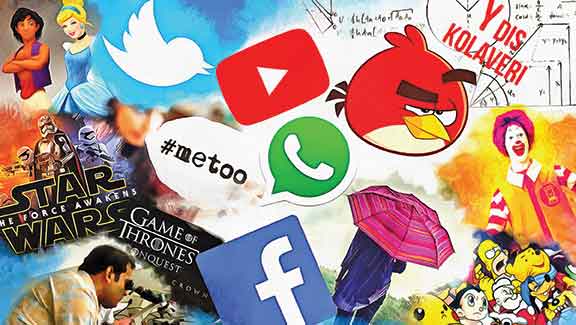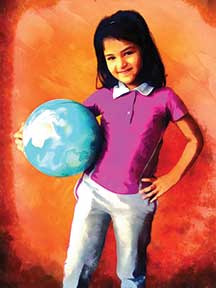Usha Pandit
Culture is identity. It represents immersion in social and ethical values that a society embraces, practices and cherishes. It has an emotional impact on people, many of whom fight hardships to preserve it against what they perceive as corruption or attempts at annihilation by outside forces.
Food, language, dress and music are basics of belonging that we relish and conserve culturally. Myths and stories reinforce these features in our minds as children and create coordinates of familiarity and affection, a sense of comfort, bonding, pride in community leading to patriotism, and shared religious kinship. Movies, songs, dance, films, television, newspaper articles, books and Net sources validate and further deepen these attitudes and values. Religious and political symbols create a sense of unity. Essentially, children who are immersed in their culture are comfortable and feel safe.
However, colonization, conquests and globalization have created mergers in culture and changed the original ones irrevocably, generating feelings of inadequacy, resentment or awe. The Internet and television are changing the aspirations of rural India. Mobility is high and so is displacement. Certain societies fear cultural erosion, and this has led to religious fundamentalism with its backlash of terrorism. Divisions based on past historical events are common. Cultural influences cause breakaways from parental values, hence dating, premarital sex, smoking weed, LGBT acceptance, and an inability to practice delayed gratification are often areas of disagreement.
Adoption of global cultures cause cultural meshing, and add colour and enrichment to monochrome lives. We wear Levi jeans, eat sushi in Greece, see French movies in Cambodia, watch rugby in New Zealand and may have a friend on the Net from Sweden. There is a new found freedom amongst the young with changing mores on sexuality, morality and religion.
A natural fallout of all this is stress and anxiety experienced by children in a consumer driven, high expectation world. There is information anxiety, opportunity anxiety, choice anxiety, competition anxiety, culture erosion anxiety, stress anxiety from relationships and so on and so forth. Time, space and speed have fused to create angst in the individual and society. Children are vulnerable and confused without the advantage of adults’ perspectives in long-term consequences and experience. The gap between the traditional and the mainstream creates conflicts. Disorientation, isolation, bewilderment can result. Unsupported, they resort to behaviour that ranges from rage to bullying, depression, sexual perversions, violent tantrums, and in extreme cases, suicide.
A good high school curriculum should infuse culture studies in mainstream literature, social studies and arts to promote better understanding of how people are affected by diverse practices and yet how the universal emotional content of man remains unchanged. This is an extremely important lesson that promotes understanding, empathy, tolerance, even appreciation and peace. As part of critical thinking, issues of conflict in the world can be discussed and debated to see how thinking and values are shaped by culture and how a thwarted culture can lead to feelings of threat and provoke hostility.
Unimaginative pedagogical practices that are insensitive to student interest and aspirations are often at the heart of boredom, low absorption, poor retention, lack of application and shaky competencies in education. Methods that are in tune with current cultural circumstances of the young learner may not be the same in a wide country like India. So the city youth could be influenced by western media, dress and food and certainly language, whereas rural youth could be fascinated by local humour, Bollywood fashions and movie songs and dialogues. Hence books and resources that cater to a one size fits all will affect both parties mentioned above adversely. In a large plural country, the stakeholders for culturally sensitive curricula are many. We also see this syndrome as a hurdle when city children are enrolled in IGCSE and IB boards where parts of the curriculum make allusions to patterns of living and issues that are alien and unknown in India. This requires a learning and then an appreciation. This also subtly alters the values of children if they are not equally exposed to their own traditional cultures. Hence a good enquiry curriculum must ensure a wide exposure to several cultures with special reference to indigenous ones. We, as a country, have plenty to draw from our plural cultures.
Let us look at a few examples of how popular culture can be used effectively to grab attention, sustain interest, get better concept study and bring forth creativity in children.
- A Hindi class using songs of monsoon to get children to create a target vocabulary list to use in their composition on the rainy season. Look at popular soaps and serials, both local, regional and others, to comment on motifs, values, emphasis, lifestyle recommendations, superstition, exclusion of societal segments, and stereotypes for critiquing them.
- Harvest festivals and rituals seen through folk songs to learn about crops in various geographic biomes, and farming practices that aid the study of geography, science and biology. A report, a letter, a PPT, an empathetic essay can integrate English.
- Use traditional, tribal, regional and international art, literature and music as starters to study landscapes, community life, and social issues.
- Use stories in literature to make switches in settings to see how actions and manners shift, yet universal human values remain constant encouraging greater inter-cultural bonding and empathy. For example, set Cinderella in Arabia or China or Rajasthan to see how change and constants play out.
- Learn from a variety of sources and then create media presentations, blogs, dance or drama to tell the stories in history or science. Topics: The Atom revolts. The Mountain remembers.
- Do a quiz using animals, flora and fauna to decipher climate; or use clothes to understand occupational hazards; or use photographs to identify the country.
- Get children to form a moderated closed chat group and put up points of research to discuss issues like suppressed news, scams that rocked the world or atrocities against women.
- Visit museums, hospitals, institutions, camps, read blogs, interview experts, and view documentaries in order to create own videos on topics like Refugee Tribulations, Anger Management, and Geriatric Diseases.
- Email friends of parents to find out problems they had in school with teachers; call on marriage bureaus to find statistics of successful arranged marriages; study processes for disaster management with regard to food served at local community kitchens.
- Imagine walking into class and singing ‘Jimmiki Kammal’ or ‘Kolaveri di’ and looking into the factors of how and why songs go viral; talk to entrepreneurs and digital companies about problems of selling homemade products worldwide through the Net.
- Survey restaurants to see how eating habits of people have changed locally; interview clients of roadside vendors who serve up local Chinese cuisine for comments on hygiene and nutritional values. Do an analysis of junk food advertisements, beauty products, and fitness gyms to evaluate their claims. Examine nutrition values of mid-day meals.
- Use urban dictionaries, teen magazines, cartoons, graffiti, and graphic novels and compare them to older versions to evaluate themes, ideas, growth or deterioration, effectiveness, and influence; study types of art across history till modern day new teen art, and create a Youtube video with commentaries. Use political cartoons from around the world to see how they treat satire.
- Study world heritage tourist areas to suggest a bucket list for middle-aged couples and make scripts for tour guides; do a food map of a country to see the influence of land, climate, availability and external influences that are killing traditional diets; study the health food industry and make a report; study how many foods that were considered unhealthy once are being delisted now and research what experts say about home remedies.
- Study posters, photos, installations, advertisements to write an essay on the topic: Protests. Study the dialogues of Socrates, the Trial of Nuremberg, and Letters of Jawaharlal Nehru to start conversations about these historical times.
- Read Horrible Histories and do a quiz. View games like Civilization and Sim 3, historical films and google earth to use the information to make a variety of products.
- Use Angry Birds for geometry; Game of Thrones to study political machinations, power equations, violence and authority; and the current #MeToo campaign to empathize and find solutions for sexual harassment.
When popular culture is used in study there are several concepts explored, debated, analyzed, viewed with interest, and understood holistically. It is a win-win for the teacher and the students. What we are doing is entering their world and allowing them to learn through their resources even as we weave present and future worlds in, for comparisons. It is a new way of approaching education. If one were to consider the fact that most of what is learnt as rote and regurgitation in conventional school programmes is forgotten, we can be sure that by using popular culture we will find greater engagement, focus and retention and study will be pleasurable, use multiple skills and create autonomy. What is more, we will be promoting peace and goodwill across the world.
The author is Founder CEO of Mindsprings and is a teacher trainer, academic consultant for schools, and the author of Empowering English, Language with Ease and Writing with Ease. She can be reached at usha_mail@yahoo.com. Website: www.mindsprings.in.


